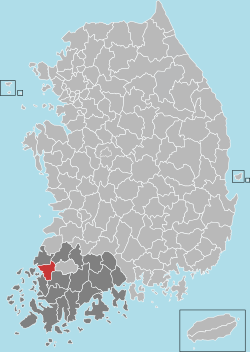History
Hampyeong used to be called Jinguk(진국) in prehistoric times, and Mahan in the Samhan age. Mahan consisted of 54 smaller counties, and it is estimated that one or two of these counties were part of present-day Hampyeong County according to the evidence of dolmens in the area. [2]
Hampyeong was divided into two hyeon, Gulrae-hyeon and Daji-hyeon during the reign of Baekje Kingdom (18 B.C ~ 660 A.D.). Gulrea-hyeon was called Hampyeong-hyeon during the reign of the Silla Kingdom and in the Goryeo Kingdom. Today it covers Hampyeong-eub, Sonbul-myeon, Singwang-myeon, and Dadong-myeon.
In the 9th year of King Taejong of the Joseon Dynasty, Hampyeong-hyeon and Mopyeong-hyeon were fused into Hampyeong-hyeon, and consisted of 14 myeon; Donghyeonrae-myeon, Suhyeonrae-myeon, Yongpung-myeon, Haejae-myeon, Dagyeong-myeon, Dadong-myeon, Sonbul-myeon, Singwang-myeon, pyeongreung-myeon, Sinji-myeon, Haebo-myeon, Wolak-myeon, Modong-myeon, Daeya-myeon.
On May 26, 1989, Hampyeong-hyeon changed its name to Hampyeong county. On November 11, 1932, Sikji-myeon and pyeongreung-myeon were annexed, and Nasan-myeon was added. On January 1, 1963, Hampyeong-myeon became Hampyeong-eub and it consisted of one eup and 8 myeons.
On July 1, 1973, Sang-ok, Wolsong, Geumgok, and Baekho were annexed into Dadong-myeon.
This page is based on this
Wikipedia article Text is available under the
CC BY-SA 4.0 license; additional terms may apply.
Images, videos and audio are available under their respective licenses.



